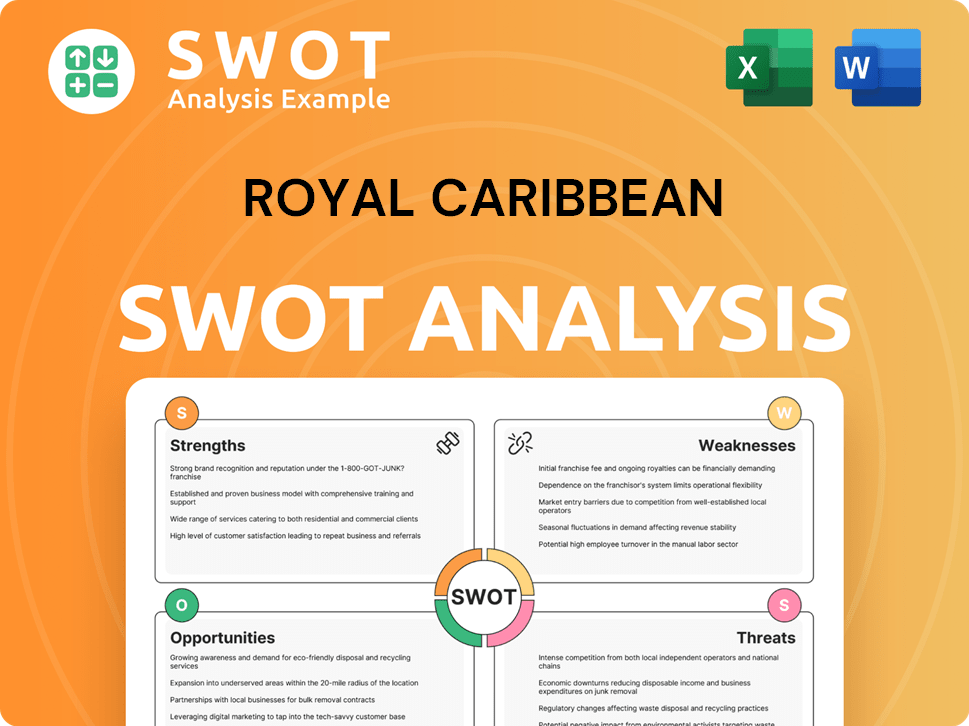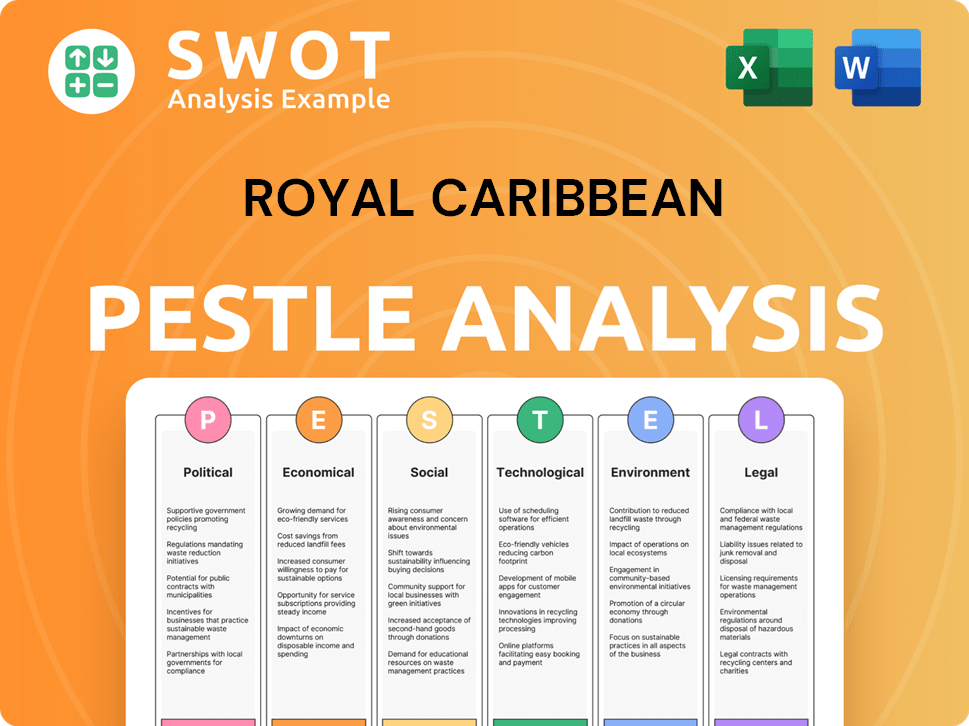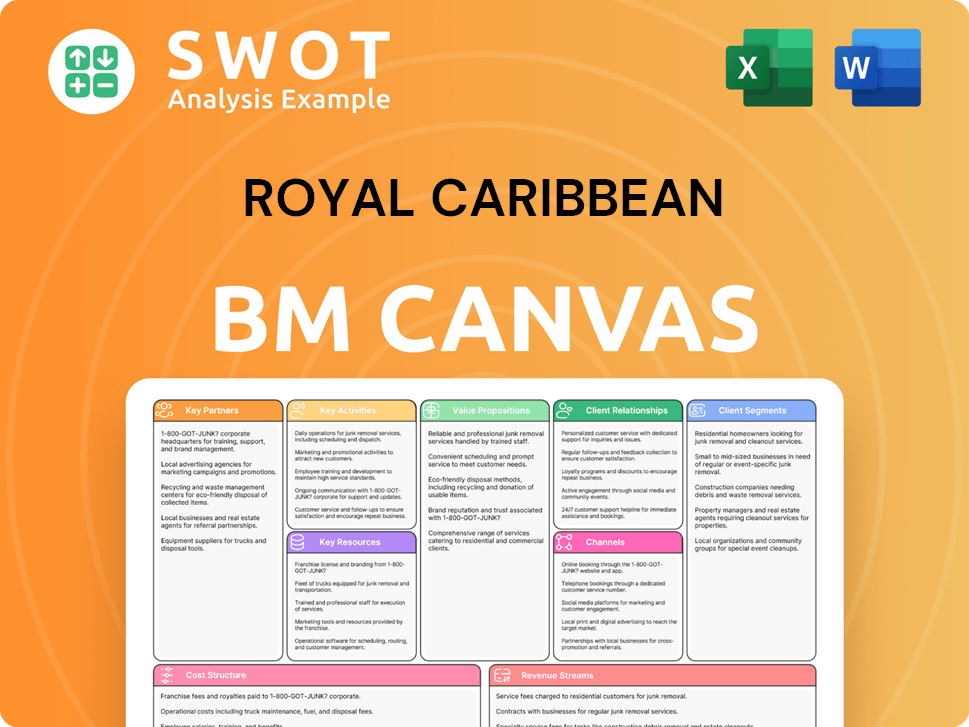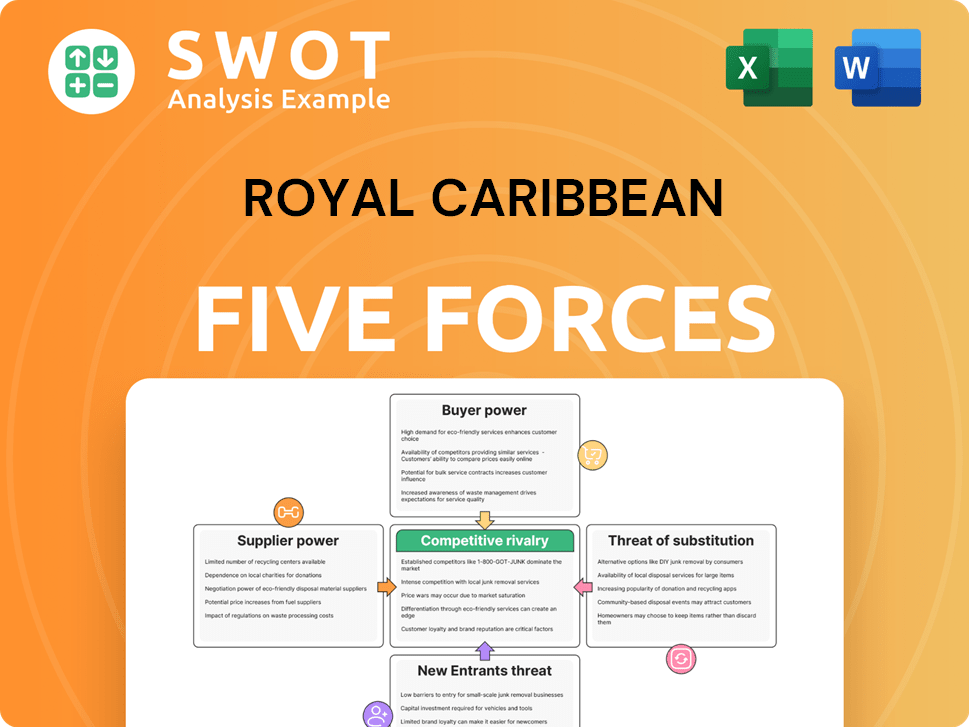Royal Caribbean Bundle
Can Royal Caribbean Maintain Its Dominance in the Cruise Industry?
The cruise industry is a dynamic sector, and Royal Caribbean has consistently demonstrated the importance of a robust growth strategy. From its humble beginnings, Royal Caribbean has become a global leader, with its Oasis Class ships, like the Oasis of the Seas, revolutionizing the passenger experience. This company analysis will explore how Royal Caribbean plans to navigate the future.

Royal Caribbean's journey from a single ship to a global cruise line showcases the effectiveness of its past strategies. Today, the company is focused on continued expansion and strategic innovation. Understanding the Royal Caribbean SWOT Analysis is crucial to grasp its current market position and future prospects, including its revenue growth strategies and plans for new ship launches.
How Is Royal Caribbean Expanding Its Reach?
The expansion initiatives of the Royal Caribbean Group are multifaceted, focusing on fleet growth, geographical diversification, and enhancing guest experiences. These strategies are designed to capture a larger market share and solidify the company's position within the competitive cruise industry.
A key element of the Royal Caribbean growth strategy involves introducing new ships with advanced technology and increased capacity. This expansion is crucial for attracting new customers and offering diverse itineraries, which is a core component of the company's long-term business plan. The company is also strategically expanding its presence in various geographical locations.
The company's focus on expanding private destination experiences is another critical aspect of its expansion strategy. This includes developing new private destinations or enhancing existing ones to create unique selling points and improve the overall value proposition for guests. These initiatives are vital for the company's future prospects and revenue growth strategies.
The launch of new ships is central to the Royal Caribbean's expansion. The Icon of the Seas, launched in January 2024, is the first of the Icon Class and the world's largest cruise ship. This represents a significant investment in expanding capacity and enhancing the guest experience. The Star of the Seas is scheduled to debut in 2025, further expanding the Icon Class fleet.
Royal Caribbean is diversifying its deployment to cater to evolving traveler preferences and access new markets. While the Caribbean remains a core market, the company is expanding in regions like Europe, Alaska, and Asia. The Utopia of the Seas, launching in July 2024, will offer short cruises to Nassau and CocoCay. This diversification aims to mitigate risks and capture a broader customer base.
Expanding private destination experiences, such as CocoCay, enhances the overall value proposition. The development of new private destinations or enhancements to existing ones is a key component of their product expansion strategy. This strategy creates unique selling points for the company.
Royal Caribbean's strategic initiatives are designed to increase its market share and revenue. The company's expansion into new markets and the introduction of innovative ships are crucial for maintaining a competitive edge. The company's focus on customer experience improvements is also a key factor in its growth.
These strategic initiatives are designed to capitalize on cruise industry trends and enhance the company's financial performance. For a deeper understanding of the financial aspects, you can explore the Revenue Streams & Business Model of Royal Caribbean.
Royal Caribbean's expansion strategy includes new ship launches, geographical diversification, and enhanced private destinations. The launch of Icon of the Seas in 2024 and Star of the Seas in 2025 are examples of fleet expansion. Diversification into regions like Europe and Asia is also a priority.
- Fleet Expansion: Launching new, larger, and technologically advanced ships.
- Geographical Diversification: Expanding presence in Europe, Alaska, and Asia.
- Private Destination Development: Enhancing and creating new private destinations.
- Customer Experience: Improving overall value proposition for guests.
Royal Caribbean SWOT Analysis
- Complete SWOT Breakdown
- Fully Customizable
- Editable in Excel & Word
- Professional Formatting
- Investor-Ready Format

How Does Royal Caribbean Invest in Innovation?
The Royal Caribbean growth strategy hinges significantly on continuous innovation and technological advancements. This approach is crucial for maintaining its competitive edge within the dynamic cruise industry trends. The company consistently invests in research and development to enhance both ship design and onboard experiences, aiming to meet and exceed evolving guest expectations.
Technological integration is a cornerstone of Royal Caribbean future prospects, driving operational efficiencies and personalizing guest interactions. By leveraging digital tools and data analytics, the company strives to optimize resource allocation, improve service delivery, and create tailored experiences that resonate with a diverse customer base. This strategic focus is essential for achieving sustainable growth and solidifying its position in the market.
A key element of Royal Caribbean company analysis involves understanding its commitment to sustainability. The company's investments in eco-friendly technologies and practices not only reduce its environmental footprint but also attract environmentally conscious travelers. This dual focus on innovation and sustainability is critical for long-term success and adapting to the changing demands of the cruise market.
The company's investment in research and development is evident in its ship designs, such as the Icon Class ships. These vessels showcase cutting-edge technologies for entertainment, dining, and passenger comfort. This includes advanced environmental systems and innovative onboard experiences.
The company is deeply invested in digital transformation to streamline operations and personalize the guest journey. This includes mobile apps for pre-cruise planning, onboard navigation, and service requests. Automation is also utilized in various ship operations.
Royal Caribbean explores the integration of artificial intelligence (AI) and the Internet of Things (IoT). These technologies help gather data, predict guest preferences, and offer tailored experiences. This leads to personalized recommendations and smart staterooms.
The company's focus on sustainability extends beyond propulsion, encompassing advanced waste management systems, water purification technologies, and energy efficiency initiatives. These innovations attract environmentally conscious travelers and demonstrate the company's leadership in sustainable tourism.
Mobile apps are used for pre-cruise planning, onboard navigation, and service requests. This enhances efficiency and guest satisfaction. The apps provide guests with easy access to information and services.
Automation is increasingly utilized in various ship operations, from logistics to guest services. This optimizes resource allocation and improves service delivery. Automation also helps to reduce costs.
The company's strategic initiatives include significant investments in technology and innovation to enhance guest experiences and operational efficiency. These advancements are crucial for maintaining a competitive edge and driving revenue growth.
- New Ship Launches: The Icon Class ships, like Icon of the Seas, incorporate cutting-edge technologies for entertainment, dining, and passenger comfort.
- Digital Transformation: Widespread adoption of mobile apps for pre-cruise planning, onboard navigation, and service requests.
- AI and IoT Integration: Exploring the use of AI and IoT to gather data, predict guest preferences, and offer tailored experiences.
- Sustainability Efforts: Focus on advanced waste management systems, water purification technologies, and energy efficiency initiatives.
- Market Share and Expansion: Continuous innovation supports expansion into new markets and enhances the company's competitive position.
For a deeper dive into the financial aspects and the company's strategic outlook, consider exploring resources such as Owners & Shareholders of Royal Caribbean. These resources provide valuable insights into the company's performance and future strategies.
Royal Caribbean PESTLE Analysis
- Covers All 6 PESTLE Categories
- No Research Needed – Save Hours of Work
- Built by Experts, Trusted by Consultants
- Instant Download, Ready to Use
- 100% Editable, Fully Customizable

What Is Royal Caribbean’s Growth Forecast?
The financial outlook for Royal Caribbean Group indicates a robust trajectory, supported by strong demand and strategic investments. The company's Royal Caribbean growth strategy is evident in its projections for the coming years, driven by increased capacity and effective operational management. This positions the company for continued success in the evolving cruise industry trends.
For the full year 2024, the company anticipates an adjusted earnings per share (EPS) between $9.90 and $10.10, reflecting optimistic profitability expectations. This positive outlook is further supported by record bookings in early 2024, demonstrating sustained consumer interest in cruise vacations. The introduction of new ships, such as Icon of the Seas and Utopia of the Seas, is expected to significantly boost revenue.
Royal Caribbean's strong financial performance is also reflected in its net income, which reached $1.7 billion for the fiscal year 2023, a substantial improvement from previous years. The company's strategic focus on optimizing yields and controlling costs is evident in its projected adjusted EBITDA of approximately $4.8 billion for 2024. These financial ambitions are supported by a healthy balance sheet and a disciplined approach to capital allocation. For a deeper dive into how the company approaches its marketing, check out the Marketing Strategy of Royal Caribbean.
Royal Caribbean projects an adjusted EPS between $9.90 and $10.10 for 2024. This forecast highlights the company's confidence in its ability to maintain strong profitability. The projection is supported by record bookings and increased capacity.
The company plans a 10% increase in capacity in 2024 compared to 2023. New ships like Icon of the Seas and Utopia of the Seas are key drivers of this expansion. This expansion is a core element of their Royal Caribbean future prospects.
The projected adjusted EBITDA for 2024 is approximately $4.8 billion. This figure reflects the company's focus on optimizing yields and controlling costs. This financial performance is a key indicator of Royal Caribbean company analysis.
Capital expenditures for new ships are strategically planned to align with demand growth and fleet modernization. This strategic approach supports long-term growth and enhances the company's competitive position within the cruise line expansion.
Royal Caribbean's financial outlook is positive, driven by strong demand and strategic investments. The company's focus on capacity expansion and cost management is expected to drive revenue growth and profitability. These factors contribute to a positive Royal Caribbean stock forecast.
- Record bookings in early 2024 indicate sustained consumer interest.
- New ship launches are expected to significantly contribute to revenue.
- Strategic capital allocation supports long-term growth.
- The company is well-positioned for continued success in the coming years.
Royal Caribbean Business Model Canvas
- Complete 9-Block Business Model Canvas
- Effortlessly Communicate Your Business Strategy
- Investor-Ready BMC Format
- 100% Editable and Customizable
- Clear and Structured Layout

What Risks Could Slow Royal Caribbean’s Growth?
The path to growth for Royal Caribbean Group, while promising, is fraught with potential risks and obstacles. The cruise industry is highly competitive, with established players and new entrants constantly vying for market share. This competitive landscape can pressure pricing and impact profitability, requiring continuous innovation and strategic adaptation to maintain a leading position.
Regulatory changes, such as stricter environmental standards or evolving health protocols, pose ongoing challenges. These changes can necessitate significant operational adjustments and capital investments, potentially affecting financial performance. Moreover, global events, including geopolitical tensions, economic downturns, or public health crises, can severely disrupt travel demand and cruise operations, as demonstrated by the COVID-19 pandemic.
Supply chain vulnerabilities, particularly for new ship construction and maintenance, could lead to delays and increased costs. Technological disruption and internal resource constraints, such as labor shortages, also present risks. Successfully navigating these challenges is critical for realizing Royal Caribbean's growth strategy and achieving its future prospects.
Intense competition from established cruise lines and new entrants can impact Royal Caribbean's market share and profitability. Competitors may offer aggressive pricing or innovative offerings. Understanding the Competitors Landscape of Royal Caribbean is crucial for strategic planning.
Stricter environmental regulations and changing health protocols can lead to increased operational costs and capital expenditures. Compliance with new emission standards and health guidelines requires significant investment and adaptation. The cruise industry is under increasing scrutiny regarding sustainability.
Vulnerabilities in the supply chain, particularly for new ship construction and maintenance, can cause delays and increase costs. Labor shortages, especially for skilled crew members, also pose operational challenges. Efficient management of a rapidly expanding fleet is essential.
Global events such as geopolitical tensions, economic downturns, or public health crises can significantly disrupt travel demand. The COVID-19 pandemic demonstrated the vulnerability of the cruise industry to unforeseen events. Economic instability can affect consumer spending.
Failing to keep pace with evolving consumer expectations for digital experiences and cybersecurity threats can pose risks. Technological advancements are crucial for enhancing customer experience. Investment in technology is vital for maintaining a competitive edge.
Challenges in managing a rapidly expanding fleet and labor shortages can impede growth. Ensuring adequate staffing and efficient fleet management are critical. Internal resource limitations can impact operational efficiency and service quality.
Royal Caribbean Group addresses these risks through various strategies, including diversifying itineraries and target markets. The company employs robust risk management frameworks, including scenario planning, to anticipate and prepare for potential disruptions. Investment in technology and innovation serves as a risk mitigation strategy. Continuous adaptation is key to navigating challenges and ensuring long-term success.
The company uses risk management frameworks to anticipate and prepare for potential disruptions, including scenario planning. Enhanced health and safety protocols and adjusted operational models are essential for adapting to changing travel environments. Proactive risk assessment and mitigation aim to safeguard future growth. These frameworks help in navigating the complex and dynamic cruise industry.
Royal Caribbean Porter's Five Forces Analysis
- Covers All 5 Competitive Forces in Detail
- Structured for Consultants, Students, and Founders
- 100% Editable in Microsoft Word & Excel
- Instant Digital Download – Use Immediately
- Compatible with Mac & PC – Fully Unlocked

Related Blogs
- What are Mission Vision & Core Values of Royal Caribbean Company?
- What is Competitive Landscape of Royal Caribbean Company?
- How Does Royal Caribbean Company Work?
- What is Sales and Marketing Strategy of Royal Caribbean Company?
- What is Brief History of Royal Caribbean Company?
- Who Owns Royal Caribbean Company?
- What is Customer Demographics and Target Market of Royal Caribbean Company?
Disclaimer
All information, articles, and product details provided on this website are for general informational and educational purposes only. We do not claim any ownership over, nor do we intend to infringe upon, any trademarks, copyrights, logos, brand names, or other intellectual property mentioned or depicted on this site. Such intellectual property remains the property of its respective owners, and any references here are made solely for identification or informational purposes, without implying any affiliation, endorsement, or partnership.
We make no representations or warranties, express or implied, regarding the accuracy, completeness, or suitability of any content or products presented. Nothing on this website should be construed as legal, tax, investment, financial, medical, or other professional advice. In addition, no part of this site—including articles or product references—constitutes a solicitation, recommendation, endorsement, advertisement, or offer to buy or sell any securities, franchises, or other financial instruments, particularly in jurisdictions where such activity would be unlawful.
All content is of a general nature and may not address the specific circumstances of any individual or entity. It is not a substitute for professional advice or services. Any actions you take based on the information provided here are strictly at your own risk. You accept full responsibility for any decisions or outcomes arising from your use of this website and agree to release us from any liability in connection with your use of, or reliance upon, the content or products found herein.